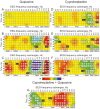Clustering Cortical Rhythms: Monoaminergic Signatures in Time-Frequency EEG Dynamics
- PMID: 40868225
- PMCID: PMC12383708
- DOI: 10.3390/biomedicines13081973
Clustering Cortical Rhythms: Monoaminergic Signatures in Time-Frequency EEG Dynamics
Abstract
Background: Multiple studies of the role of neurotransmitter systems in the effects of various substances on brain functions under normal conditions and at various brain disorders have demonstrated the relatively high usefulness of the electroencephalogram (EEG). However, little is known about EEG "fingerprints" of direct neurotransmitter-receptor interactions, in particular, for monoamine (MA) systems involved in the main brain functions. Methods: We looked at how the EEG effects of serotonin, dopamine, and norepinephrine receptors activating substances (quipazine, SKF-38393, and clonidine, respectively) injected into the brain's lateral ventricles were affected by corresponding blockers (cyproheptadine, SCH-23390, and yohimbine) in freely moving rats. We introduced a method for clustering significant changes in the EEG spectra based on specific time intervals and narrow frequency subranges. Results: Stimulating serotonin and dopamine receptors caused specific suppression of EEG activity around 10 Hz and an increase near 18 Hz, respectively. The effects were reduced after pretreatment with the corresponding receptor blockers. Clonidine produced clusters of increased and decreased EEG activity around 6 Hz and 21 Hz, respectively, which were weakened by the blocker, yohimbine. These results demonstrate the "signatures" of different MA systems in EEG time-frequency clustering. Conclusions: We consider the developed approach as a potentially useful tool in clinics for evaluation of MA transmission pathology and its therapy with corresponding substances penetrating the blood-brain barrier.
Keywords: EEG; SCH-23390; SKF-38393; agonist; antagonist; clonidine; clustering; cyproheptadine; electroencephalogram; frequency; quipazine; yohimbine.
Conflict of interest statement
The authors declare no conflicts of interest.
Figures




References
-
- Itil T.M. The significance of quantitative pharmaco-EEG in the discovery and classification of psychotropic drugs. In: Herrmann W.M., editor. EEG in Drug Research. Gustav Fischer; Stuttgart, Germany: 1982. pp. 131–157.
-
- Kurimoto E., Nakashima M., Kimura H., Suzuki M. TAK-071, a muscarinic M1 receptor positive allosteric modulator, attenuates scopolamine-induced quantitative electroencephalogram power spectral changes in cynomolgus monkeys. PLoS ONE. 2019;14:e0207969. doi: 10.1371/journal.pone.0207969. - DOI - PMC - PubMed
LinkOut - more resources
Full Text Sources
Miscellaneous

